Introduction
As the healthcare landscape continues to evolve, custom telehealth software solutions have emerged as a pivotal component in delivering efficient and accessible care. These tailored platforms not only facilitate remote interactions between patients and providers but also address the unique challenges faced by healthcare organizations.
With the telehealth market projected to soar from $45.5 billion in 2020 to an astonishing $175.7 billion by 2026, the urgency to adopt specialized solutions is greater than ever. This article delves into the essential features of effective telehealth software, the importance of seamless integration with existing healthcare systems, and the myriad benefits these custom solutions offer to both patients and providers.
Additionally, it examines the challenges inherent in developing such software, providing valuable insights for stakeholders aiming to navigate this dynamic sector.
Defining Custom Telehealth Software Solutions
Custom remote medical software platforms represent highly specialized digital tools that enable distant interactions between providers and individuals. Unlike off-the-shelf options, custom telehealth software solutions are meticulously crafted to meet the distinct requirements of healthcare organizations, ensuring seamless integration with operational workflows, adherence to regulatory standards, and consideration of diverse patient demographics. Key functionalities of these platforms may include:
- Video consultations
- Appointment scheduling
- Integration with electronic health records (EHR)
- Secure messaging capabilities
All aimed at enhancing the overall remote healthcare experience.
The demand for such custom offerings is underscored by the telehealth market's projected growth from $45.5 billion in 2020 to an anticipated $175.7 billion by 2026. Technologies utilized in these solutions include:
- Python
- .NET
- Java
- Node.js
- Various mobile development frameworks
Which enhance their functionality and adaptability. As Slava Vaniukov, CEO and Co-Founder at Softermii, notes, "How to Develop a Telemedicine App? Benefits, Features & Cost." This insight highlights the significance of customizing applications to address specific medical needs. Furthermore, the rise of telemedicine platforms has increased the need for online engagement between providers and individuals, as illustrated by the case study on Education Portals in Telehealth, which highlights the effectiveness of structured frameworks in enhancing education.
As the landscape changes, organizations that invest in custom telehealth software solutions are not only aligning with individual needs but also positioning themselves at the forefront of modern healthcare delivery.
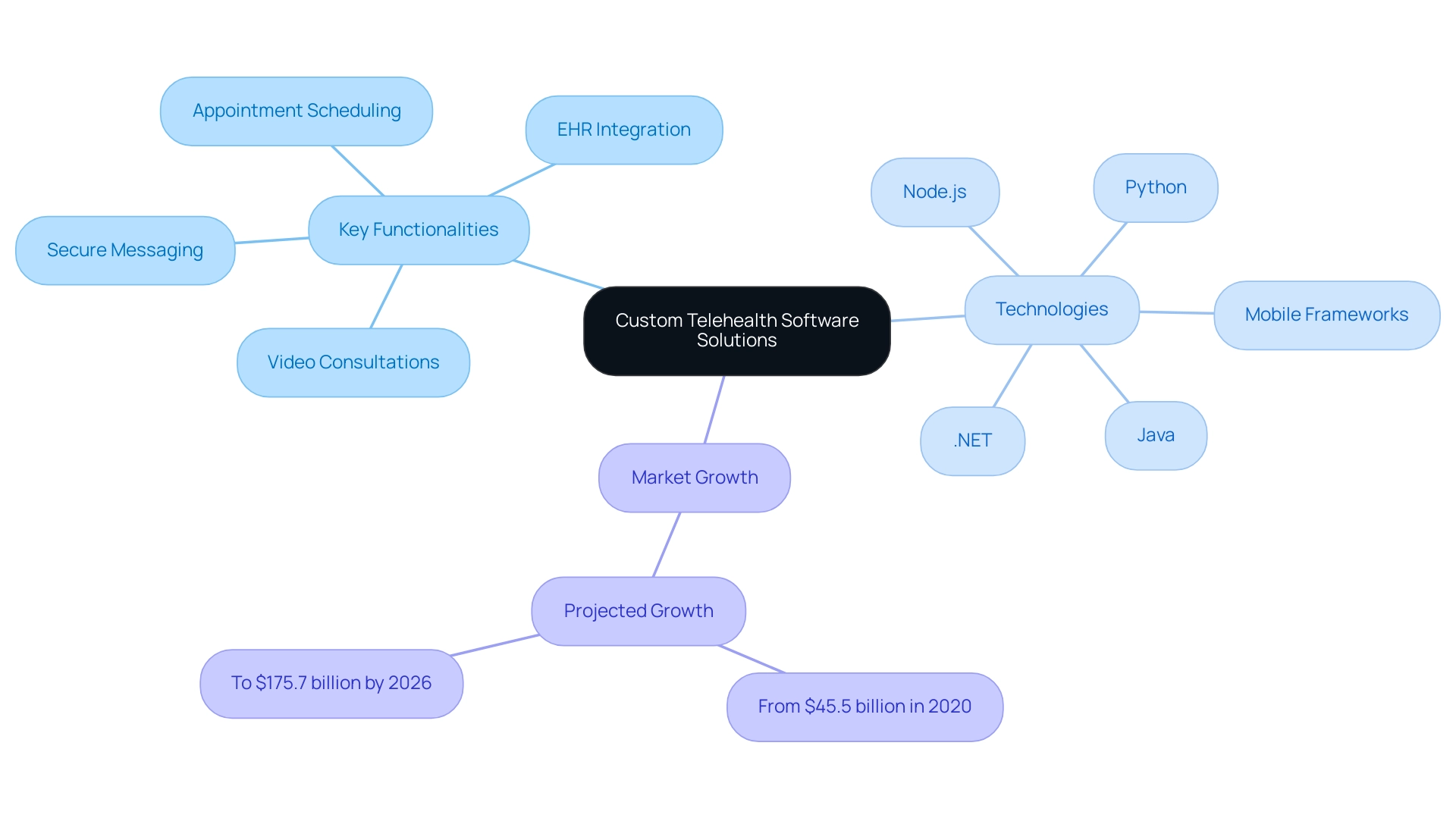
Key Features of Effective Telehealth Software
Effective custom telehealth software solutions must encompass a variety of essential features to optimize care and streamline provider workflows. Among these, video conferencing stands out as a critical element, enabling secure and high-quality video calls that facilitate face-to-face consultations, which have been proven to enhance satisfaction—82% of physicians in the UK reported their approval of telemedicine methods as of 2022.
Another essential characteristic is appointment scheduling, which should provide an intuitive interface that enables individuals to effortlessly book and manage their appointments with medical providers. This functionality not only enhances involvement of individuals receiving care but also lessens administrative pressures on medical personnel.
-
EHR integration is similarly essential, guaranteeing that telehealth systems can effortlessly link with current electronic health records. This capability guarantees that client data is readily accessible and consistently up-to-date, which is crucial for informed medical decision-making.
-
Moreover, secure messaging systems must comply with HIPAA regulations, allowing for safe communication between clients and providers. Considering that over 500 medical facilities reported data breaches impacting around 82.6 million individuals in 2023, this feature is vital for building trust and enhancing the overall patient experience.
-
Lastly, payment processing capabilities are crucial, incorporating integrated systems that facilitate billing and streamline insurance claims. As telemedicine expands, especially via third-party providers—with Global distribution at 75%—the integration of custom telehealth software solutions enhances the efficacy of remote healthcare services. Insights from the case study titled 'Key Factors Driving Telemedicine Market' also indicate that the future of telemedicine is being shaped by rapid technological advancements, positioning these features as indispensable in the evolving landscape of medical technology.
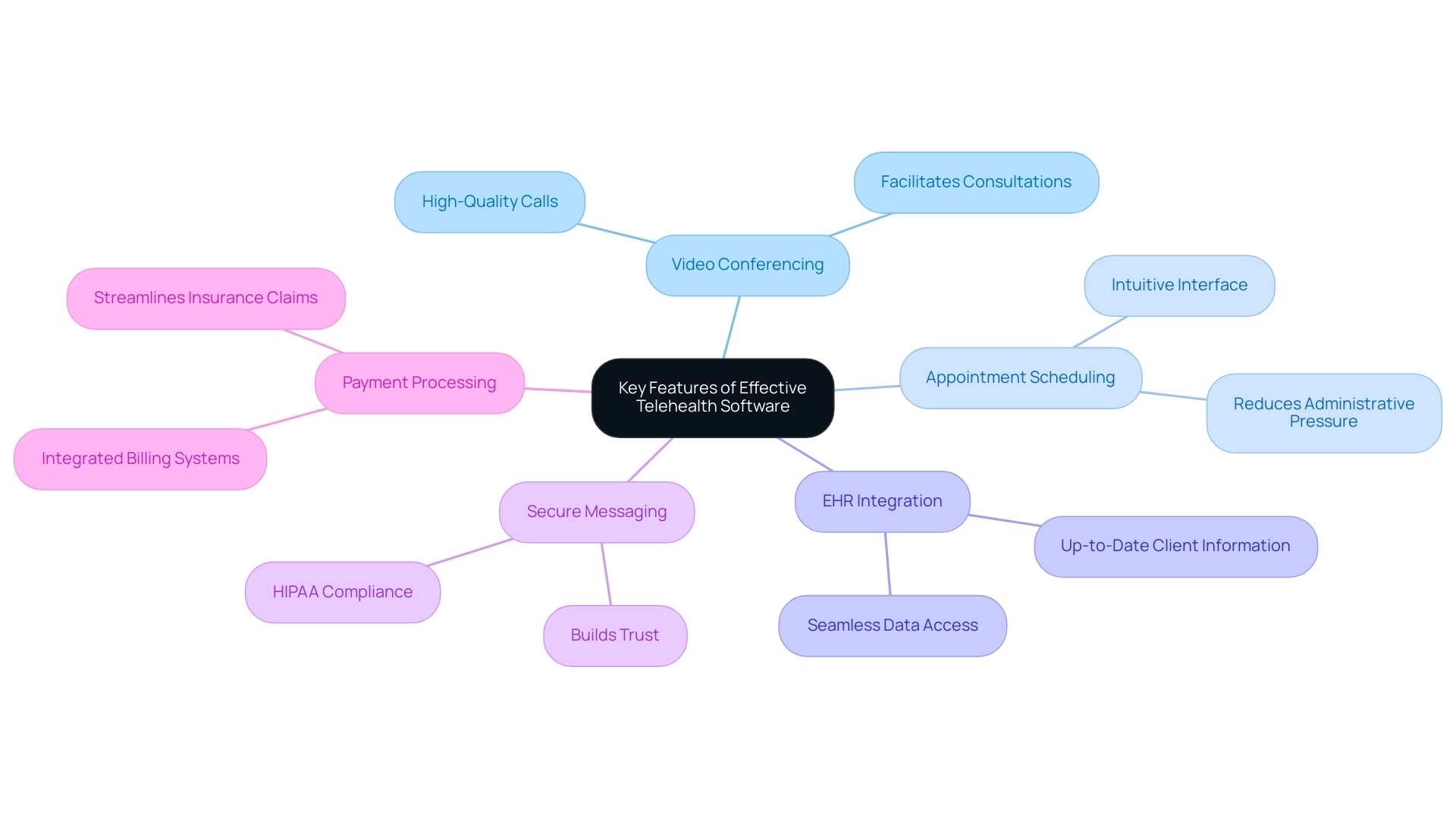
Seamless Integration with Healthcare Systems
For custom telehealth software solutions to succeed, seamless integration with existing medical systems—such as Electronic Health Records (EHRs), practice management software, and billing systems—is essential. Effective integration synchronizes data across platforms, significantly reducing the risk of errors and enhancing workflow efficiency. This capability not only streamlines administrative processes but also enables providers to maintain a comprehensive view of patient well-being, leading to better-informed care decisions.
With around 280 million individuals worldwide experiencing depression, the need for enhanced mental support is urgent, making it increasingly crucial for tailored approaches to be created with interoperability as a priority. By facilitating smooth data exchange and communication among various medical applications, custom telehealth software solutions can effectively address integration challenges projected to persist into 2024. As David Blumenthal stated, "While the other nine countries differ in the details of their systems and in their performance on domains, unlike the U.S., they all have found a way to meet their residents’ most basic health care needs, including universal coverage."
This emphasizes the significance of interoperability in medical software, which is not merely a technical requirement but a fundamental necessity for providing quality care. Furthermore, with other countries allocating between 4 percent and 8 percent of GDP on medical services in 1980, the efficiency of their systems highlights the need for effective integration. Furthermore, the Health Systems Technology (HST) sector is anticipated to rebound with a 12 percent CAGR from 2022 to 2027, fueled by continuous technology adoption, highlighting the necessity for investment in seamless integration approaches.
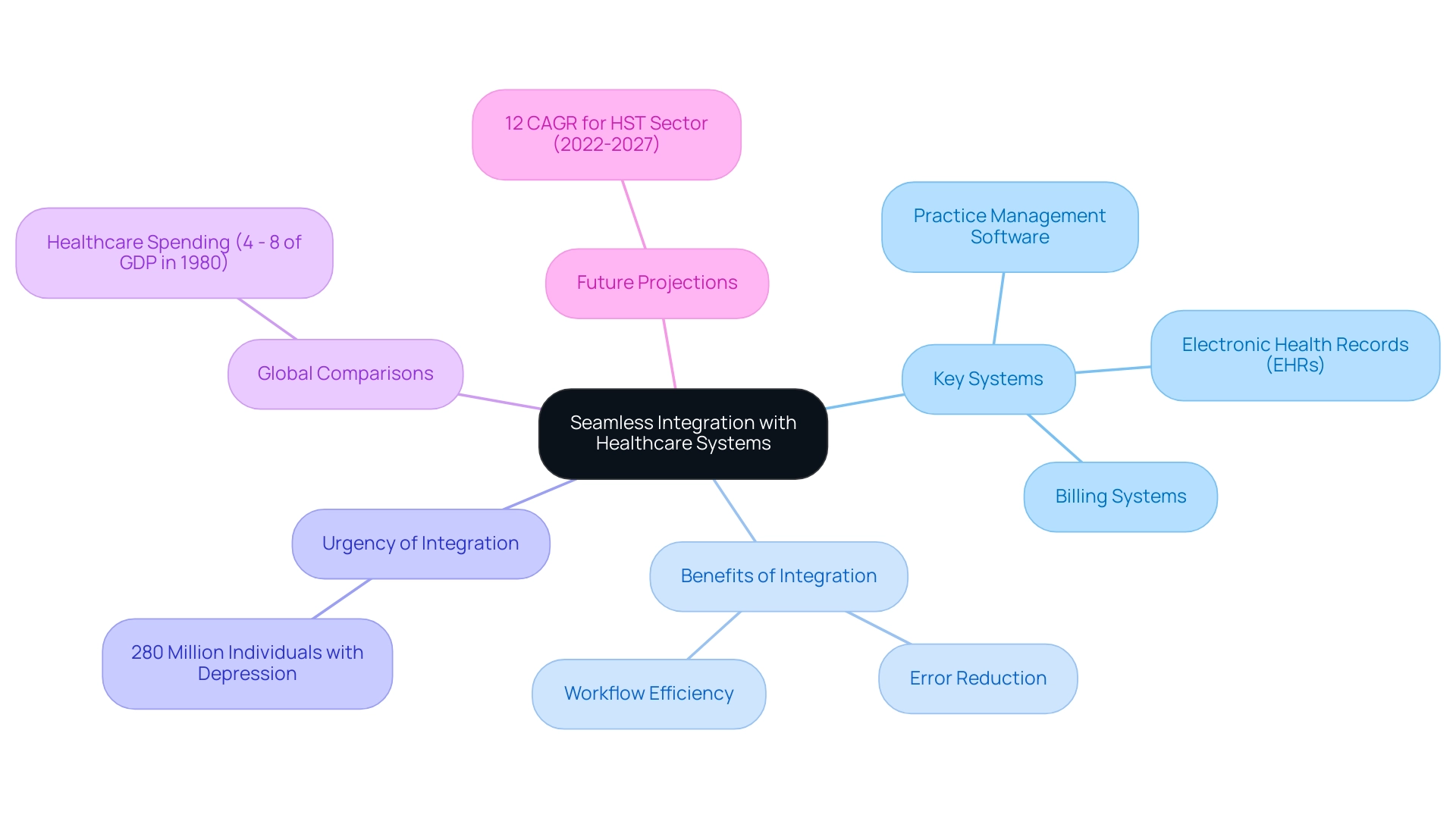
Benefits of Custom Telehealth Solutions for Patients and Providers
Tailored telemedicine offerings provide numerous benefits for both individuals and medical professionals. For individuals, these solutions significantly enhance accessibility to healthcare services, allowing consultations from the comfort of their homes. This convenience not only fosters higher client satisfaction but also boosts engagement levels.
In recent studies, satisfaction with remote healthcare services has been found to be highest among younger generations, Medicaid patients, and urban residents, illustrating its effectiveness in meeting the needs of specific demographics. However, it's important to note that only 25.1% of medical specialists used telemedicine for 25%–49% of their visits, indicating a variation in telemedicine adoption across specialties. For providers, custom telehealth software solutions enhance operational efficiency by streamlining workflows, reducing administrative tasks, and enabling more effective resource management.
The adoption of remote healthcare solutions has been associated with enhanced patient outcomes; for example, a study carried out at Ayder Comprehensive Specialized Hospital during the COVID-19 pandemic showed that 86.6% to 90.6% of patients expressed high satisfaction with remote services, and 65.1% believed that these virtual visits were comparable to conventional in-person appointments. It's also noteworthy that surgical specialists reported lower satisfaction levels and more neutral feelings regarding remote healthcare technology compared to primary care physicians and medical specialists. This positive reception underscores the potential for timely interventions and follow-ups to drive revenue growth for healthcare organizations.
As Christopher Lis observes, most consumers concur that remote healthcare is tough to beat when it comes to convenience and accessing care quickly. However, it is essential for remote healthcare providers to continuously monitor patient experiences to ensure that these approaches meet the diverse needs of all patients.
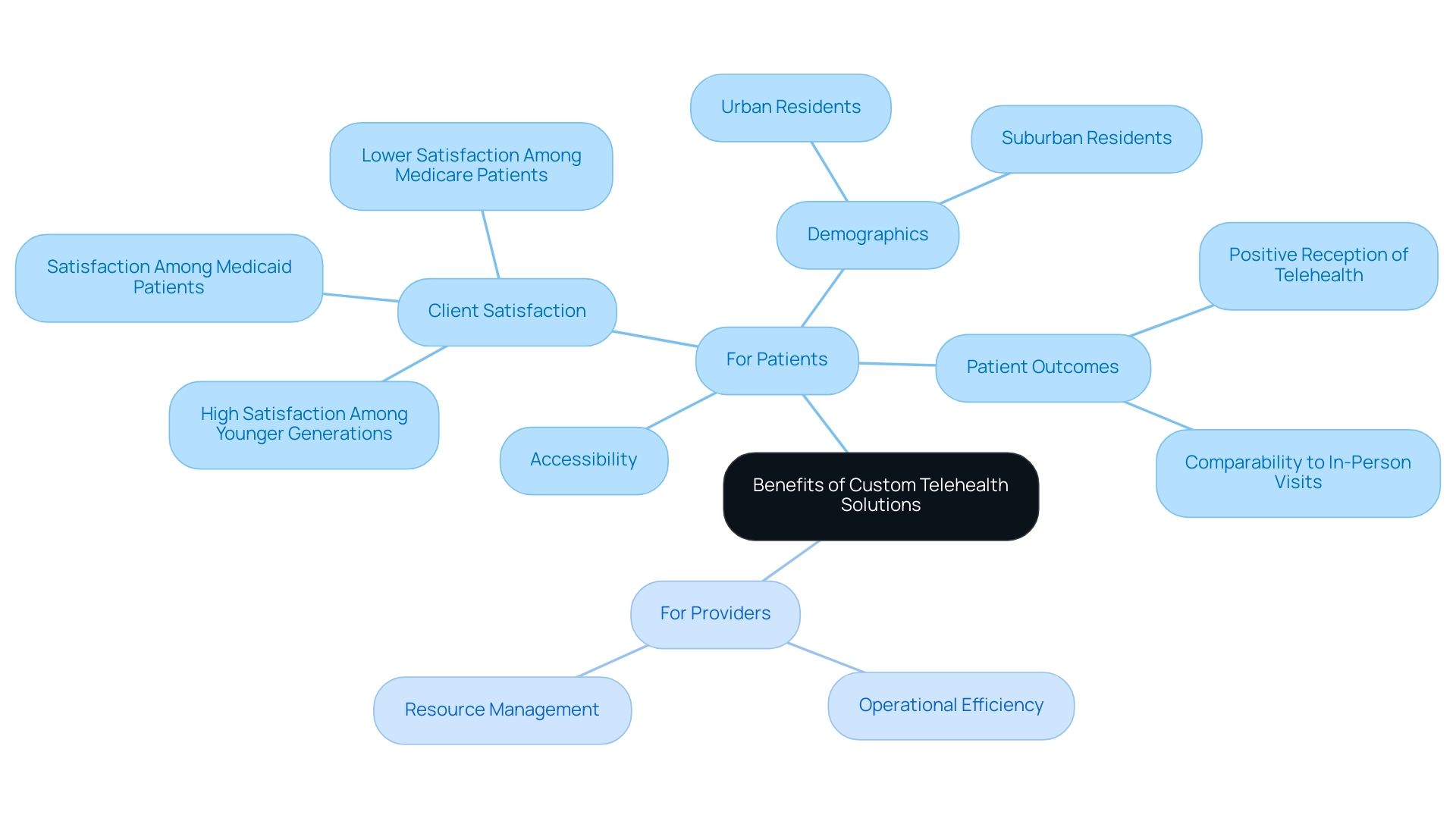
Challenges in Developing Custom Telehealth Software
The development of custom telehealth software solutions presents a unique set of challenges, particularly in the realms of regulatory compliance, user adoption, and technical integration. As the telemedicine market surged to a valuation of approximately $114.98 billion in 2023, the demand for robust solutions has never been greater. Healthcare providers must navigate intricate regulations, including HIPAA, to safeguard patient data effectively.
Dr. Michael Kane, Chief Medical Officer at Indiana Center for Recovery, emphasizes this viewpoint, stating,
However, even with these challenges, I strongly believe that remote healthcare has made a positive impact in the medical field. It has opened up new possibilities for medical delivery and made it more accessible to a lot of people. We may have to tweak and improve it along the way, but I really do see telehealth as a valuable tool in the future of medical services.
This insight reflects the dual nature of the challenges: while they are significant, the potential rewards are equally compelling. User adoption is another critical hurdle; custom telehealth software solutions that lack intuitiveness or fail to cater to the specific needs of patients and providers may struggle to gain traction. Furthermore, technical issues often arise during integration with existing healthcare systems, necessitating strategic planning and execution.
The latest statistics reveal that remote healthcare agencies report a favorable patient-to-nurse ratio of 15:1, a significant improvement compared to the 11:1 ratio in non-remote healthcare settings. This change not only shows reduced expenses but also signifies improved management capabilities, further highlighting the significance of effective custom telehealth software solutions in development.
To illustrate the advantages of remote healthcare, a case study titled 'Time Efficiency in Healthcare' demonstrates how remote services enhance time efficiency by eliminating travel and reducing waiting room durations. Individuals can accommodate medical appointments into their schedules more easily, while providers can attend to more clients daily, enhancing resource utilization.
To overcome these challenges, it is essential for stakeholders to engage end-users during the development process, conduct comprehensive testing, and prioritize a user-friendly design.
Such an approach can significantly enhance acceptance and satisfaction among both healthcare providers and patients, ultimately positioning telehealth as a vital tool in the future of healthcare.
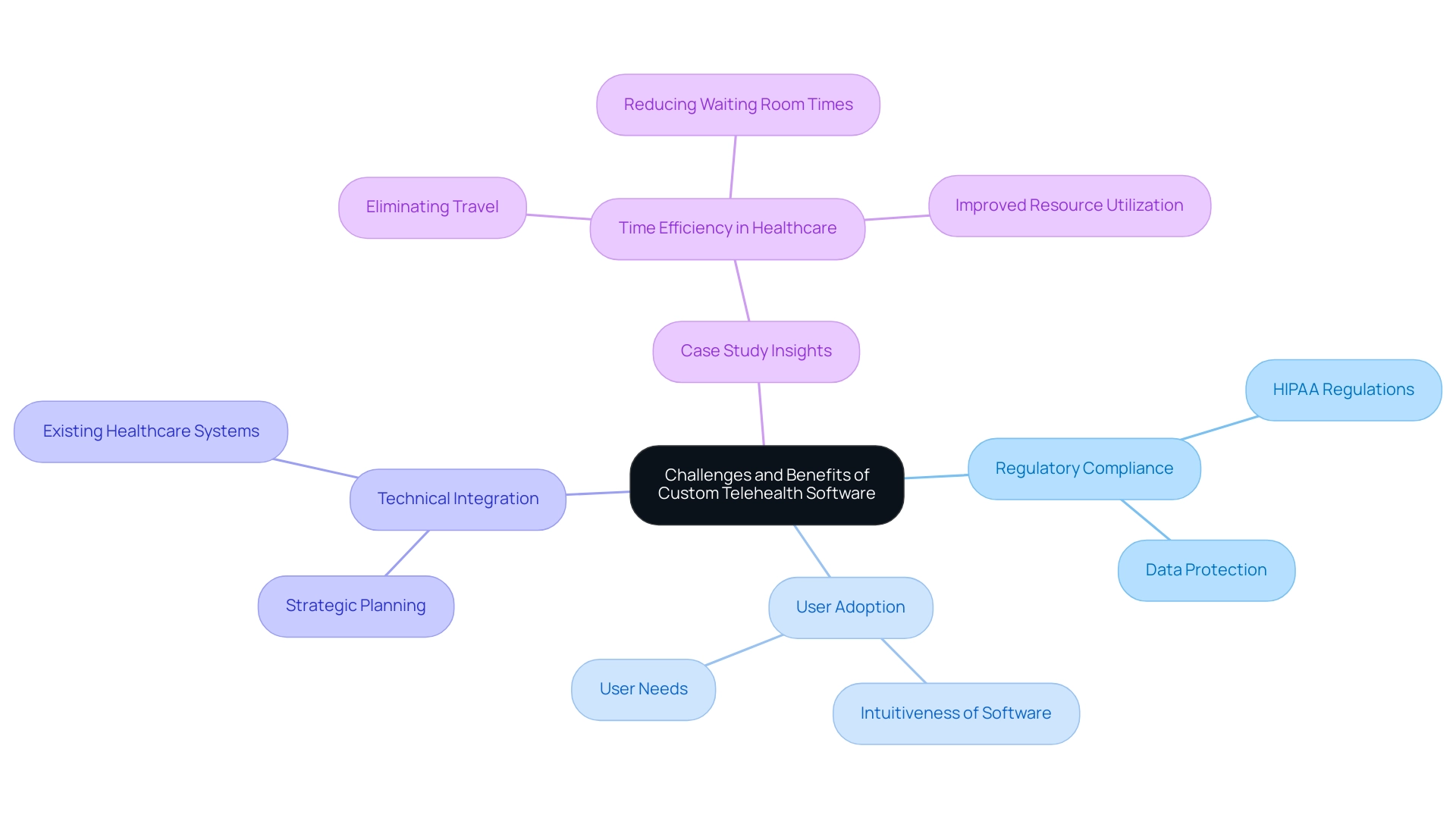
Conclusion
Custom telehealth software solutions are rapidly transforming the healthcare landscape, offering tailored platforms that enhance remote interactions between patients and providers. The key features of effective telehealth software—such as video conferencing, appointment scheduling, EHR integration, secure messaging, and payment processing—are not just enhancements but essential components that drive patient satisfaction and operational efficiency. Seamless integration with existing healthcare systems is crucial for ensuring reliable data exchange and improving the overall quality of care.
The benefits of these custom solutions extend to both patients and providers, significantly improving accessibility to healthcare services and streamlining workflows. Patients enjoy the convenience and comfort of virtual consultations, while providers can optimize their operations and enhance patient outcomes. Despite the challenges in developing such software—ranging from regulatory compliance to user adoption—the potential rewards are substantial. The telehealth market's projected growth underscores the urgency for healthcare organizations to invest in these innovative solutions.
As the demand for telehealth continues to grow, embracing custom software solutions is not merely a trend but a strategic necessity. By prioritizing tailored functionalities and ensuring seamless integration, healthcare organizations can position themselves at the forefront of modern care delivery, ultimately leading to improved health outcomes and greater patient satisfaction. The evolution of telehealth is just beginning, and those who adapt will thrive in this dynamic environment.





